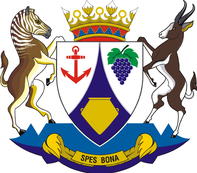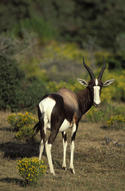The new Provincial Coat of Arms for the Province of the Western Cape was approved and enacted by Provincial Parliament in 1998. This Coat of Arms was designed by Fred Brownell, after careful research and consultations with representatives of all the political parties that were represented in the Provincial Parliament.

The elements that are used in the design were chosen to represent the uniqueness of the Western Cape. The blue base is representative of Table Mountain, Western Cape’s distinctive natural feature. Across the base encased in ostrich feathers is the motto - SPES BONA - which means “good hope”. The ostrich feathers represent the Little Karoo.
From the base is a shield, which contains an anchor, a bunch of grapes and in the centre a clay pot. The anchor represents hope, stability, faith and the provinces maritime history. The grapes represent the importance of agriculture and of course wine production in the Western Cape. The clay pot symbolises manufacturing and as an artefact of the early inhabitants of the Cape, the Khoi.

Supporting the shield there is a Quagga (Equus quagga quagga) and, the Bontebok (Damaliscus dorcas dorcas), both of which are indigenous to the province.
The quagga is currently extinct, but research is underway with a specialised breeding programme with the aim of producing a new population of them.
The bontebok was at one time close to extinction but now has a viable population. On top of the shield is a coronet, which is made up of a beaded heading, as once worn by the San, a protea, which represents the fynbos found in the province and rings which are symbolic of perfection, as they have no end and no beginning.
The new coat of arms serves to enhance the identity and dignity of the Western Cape.